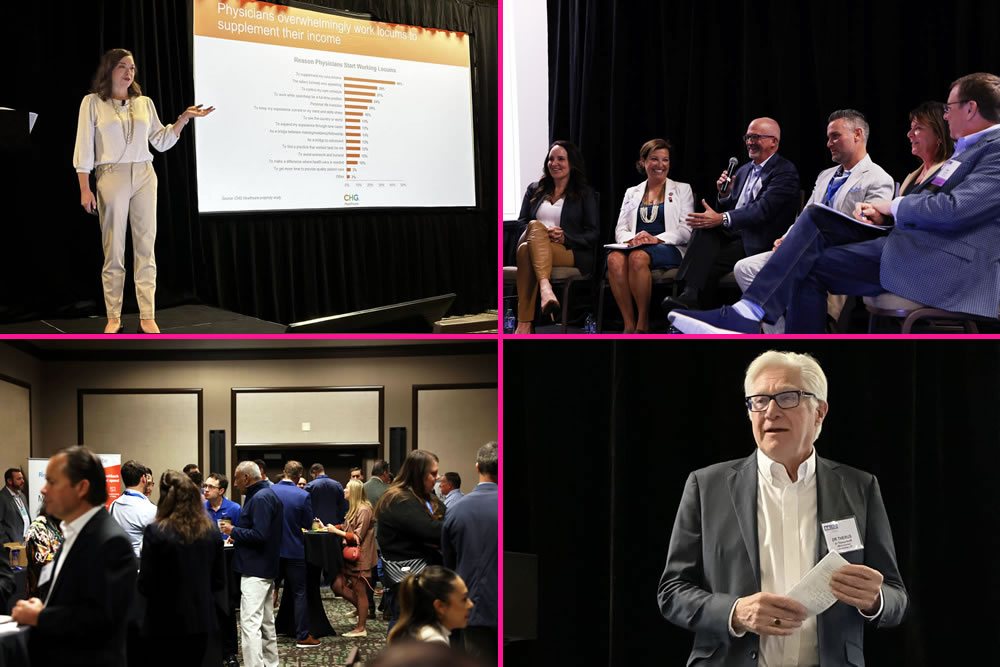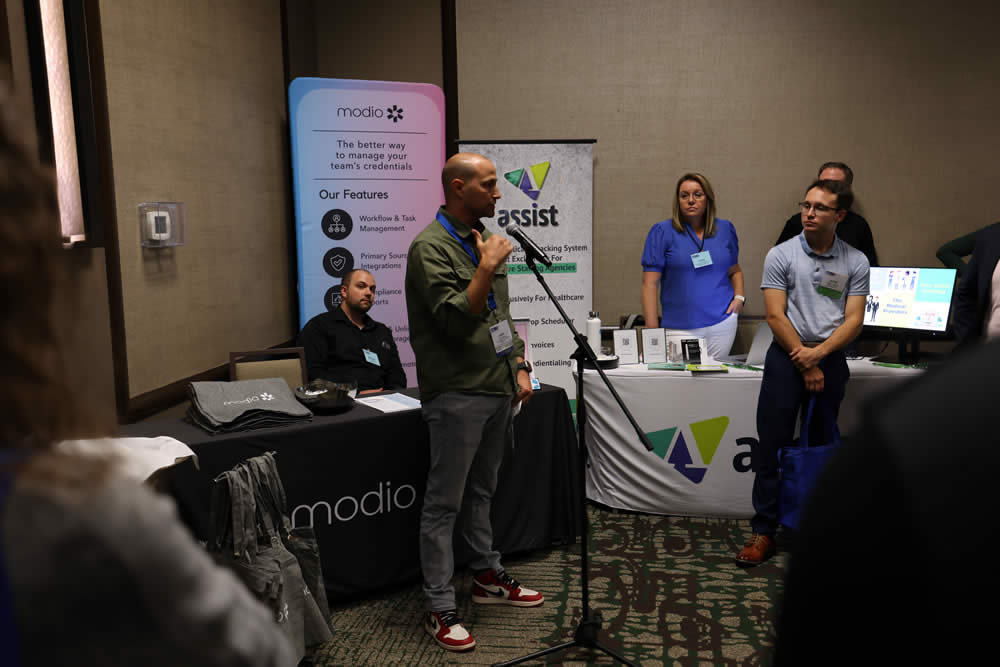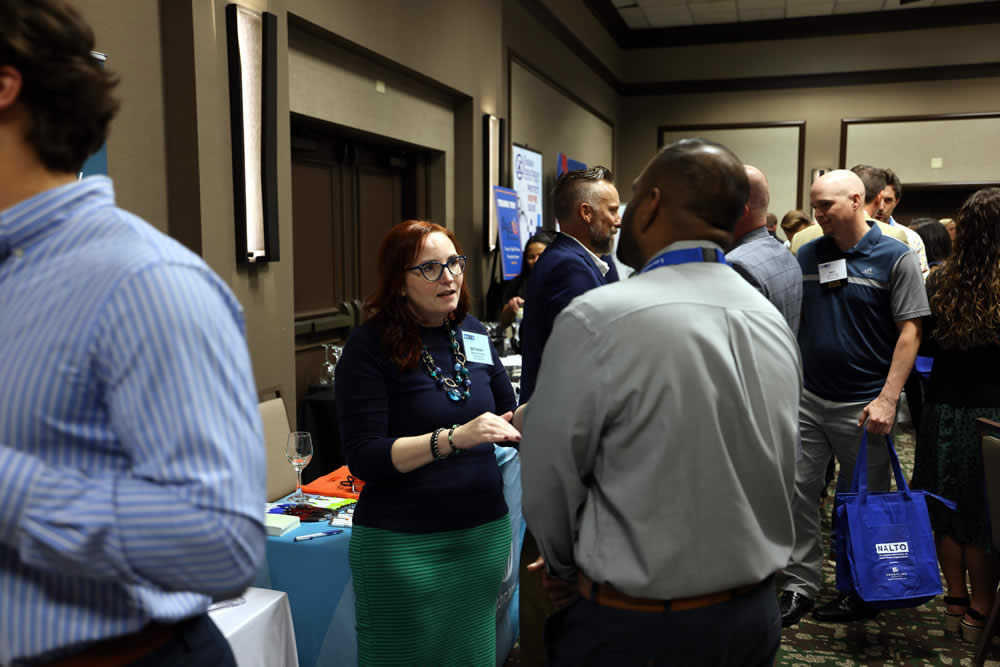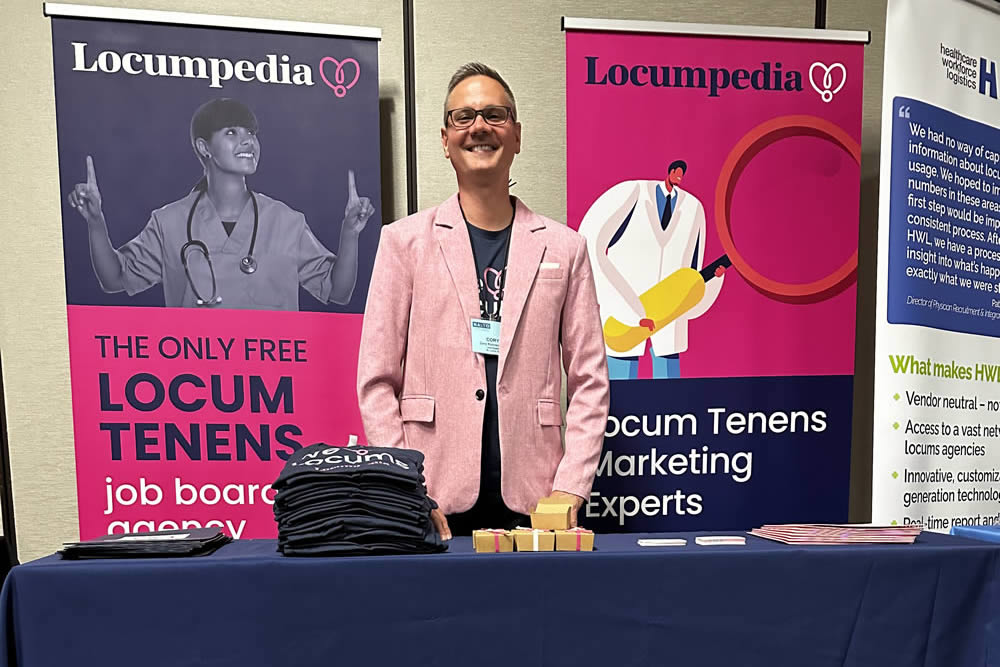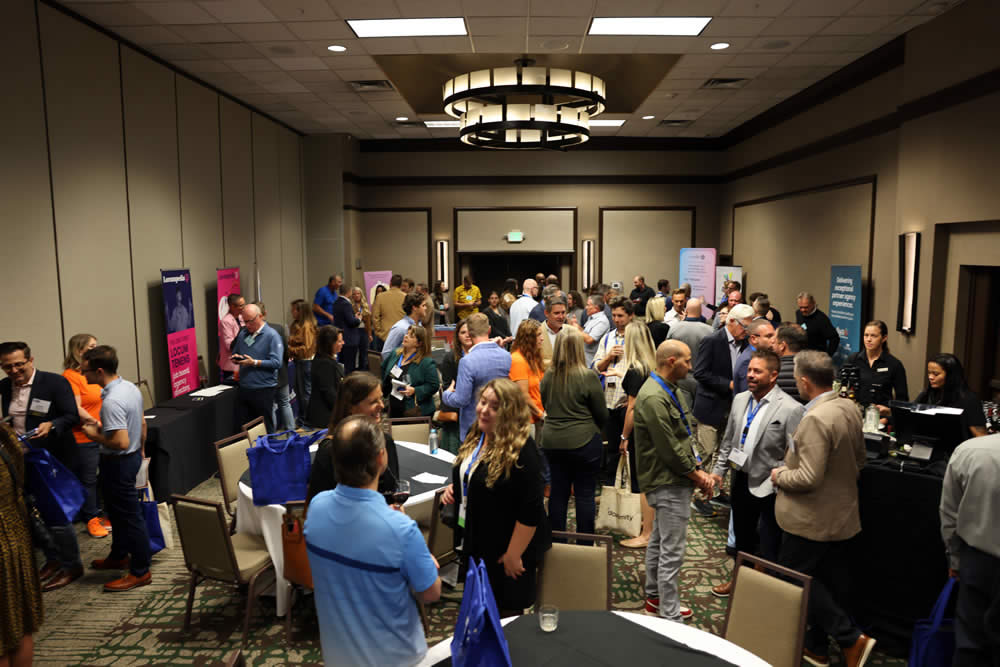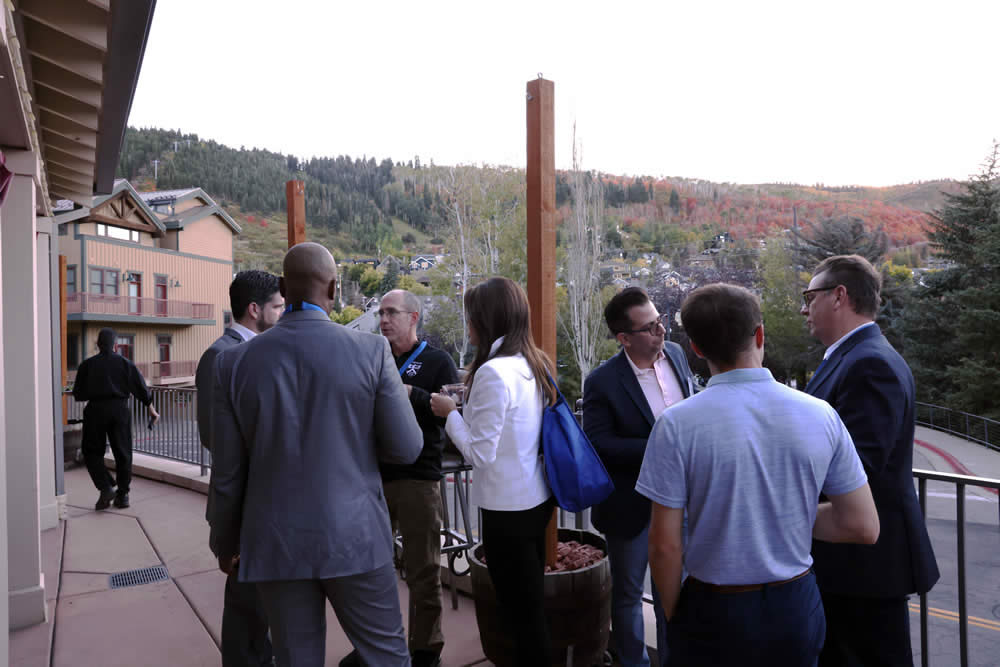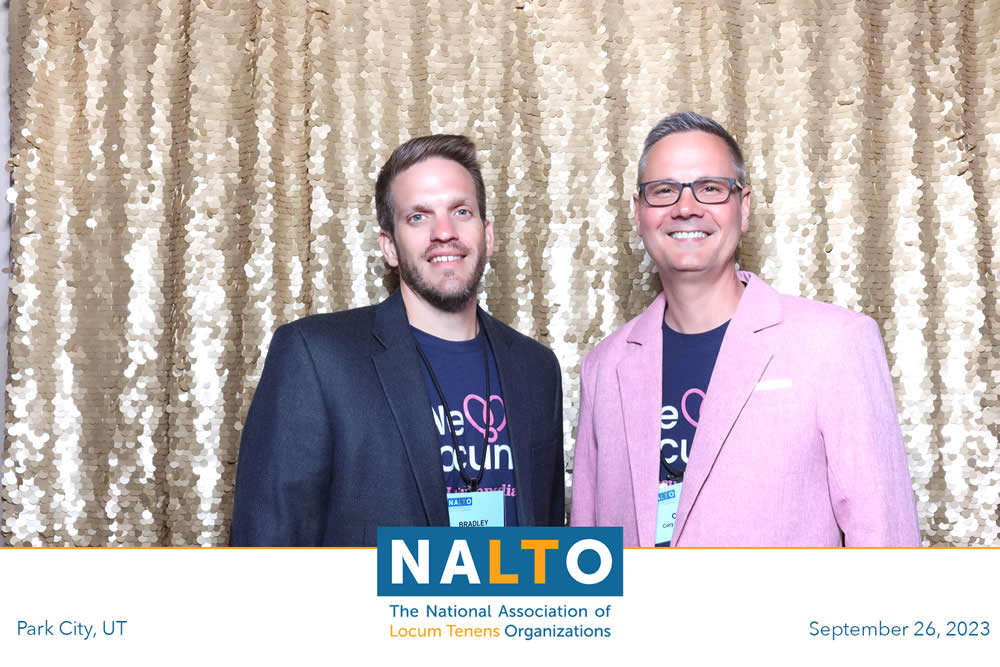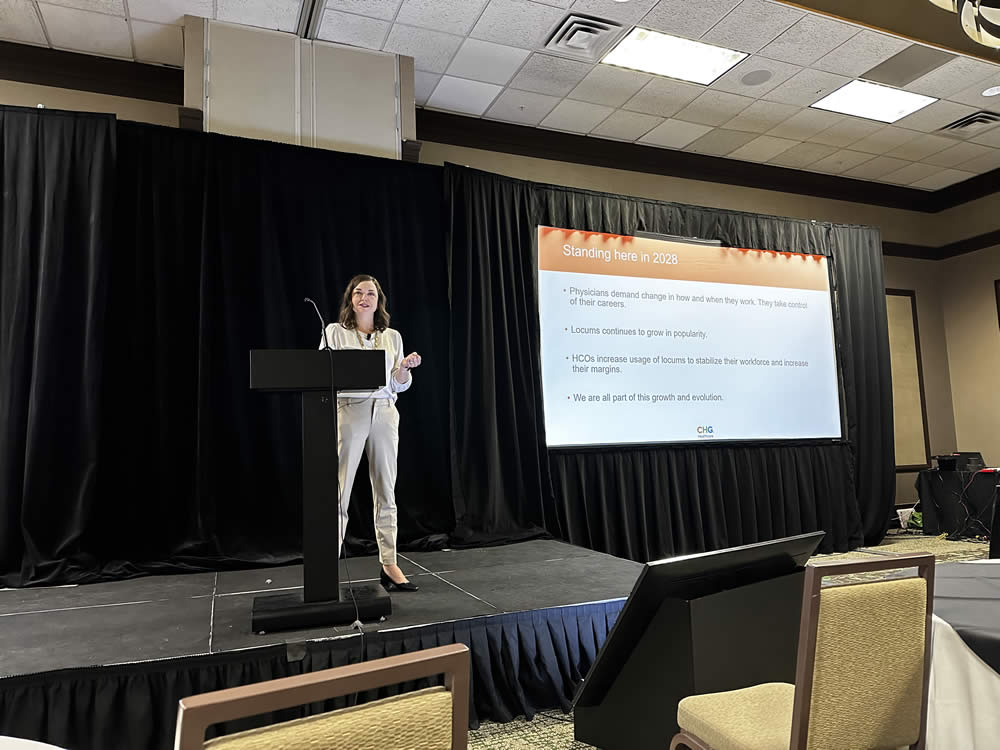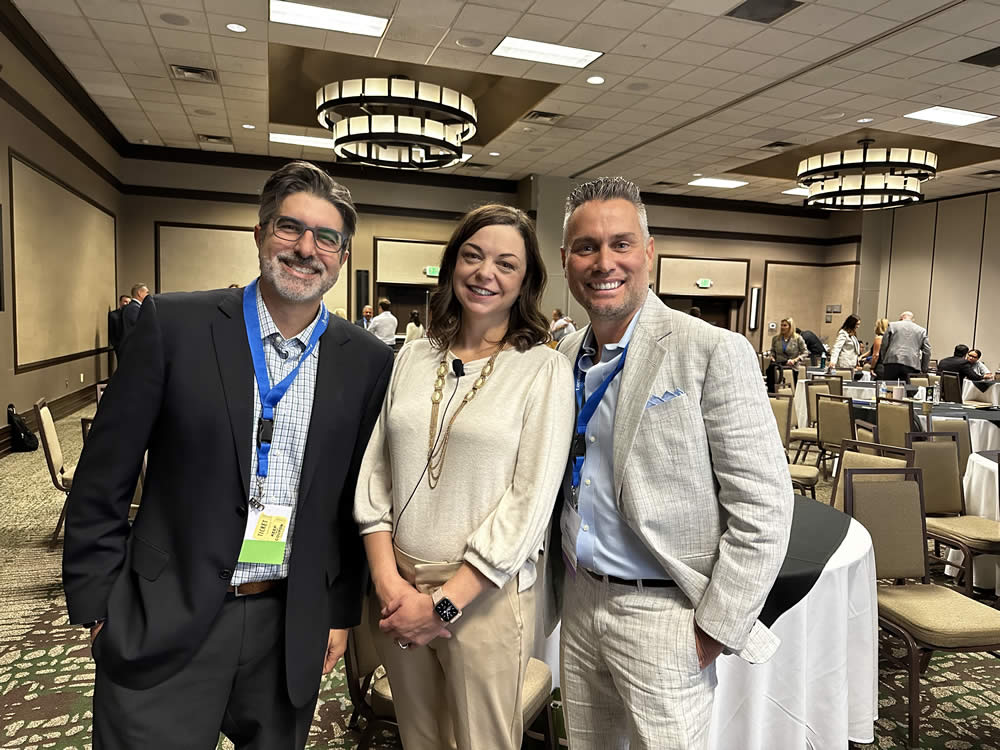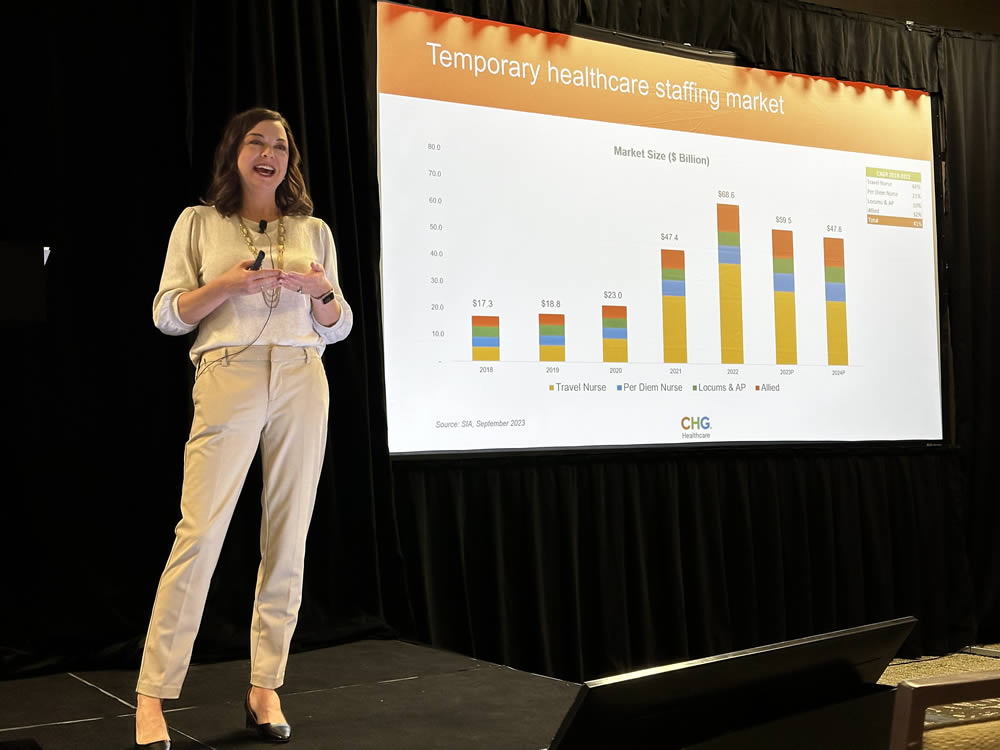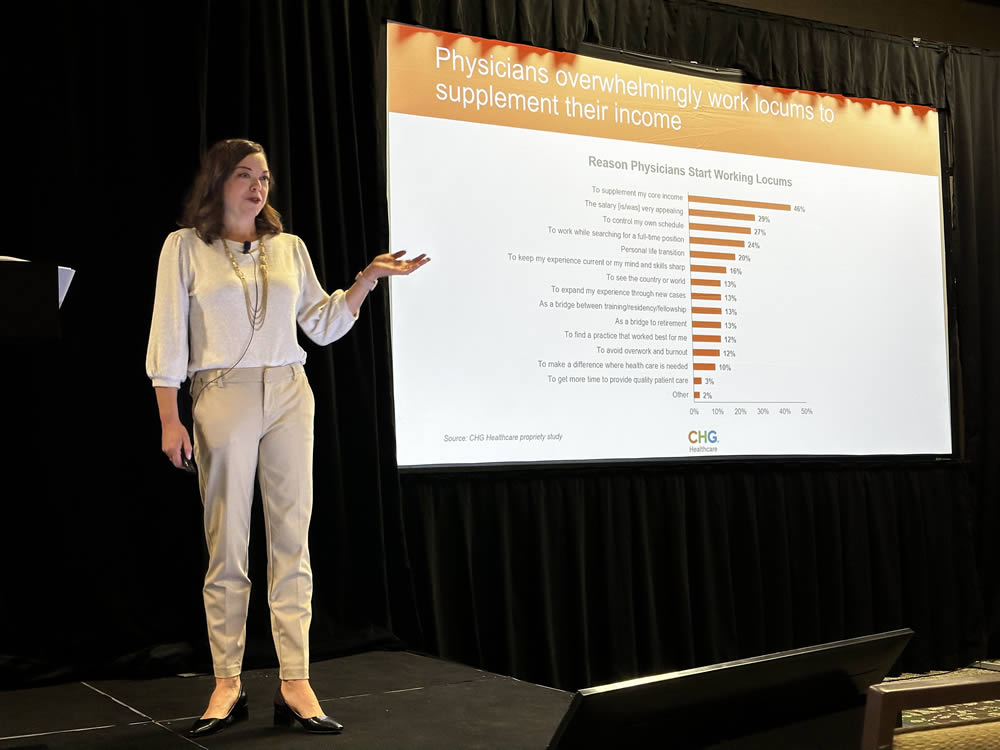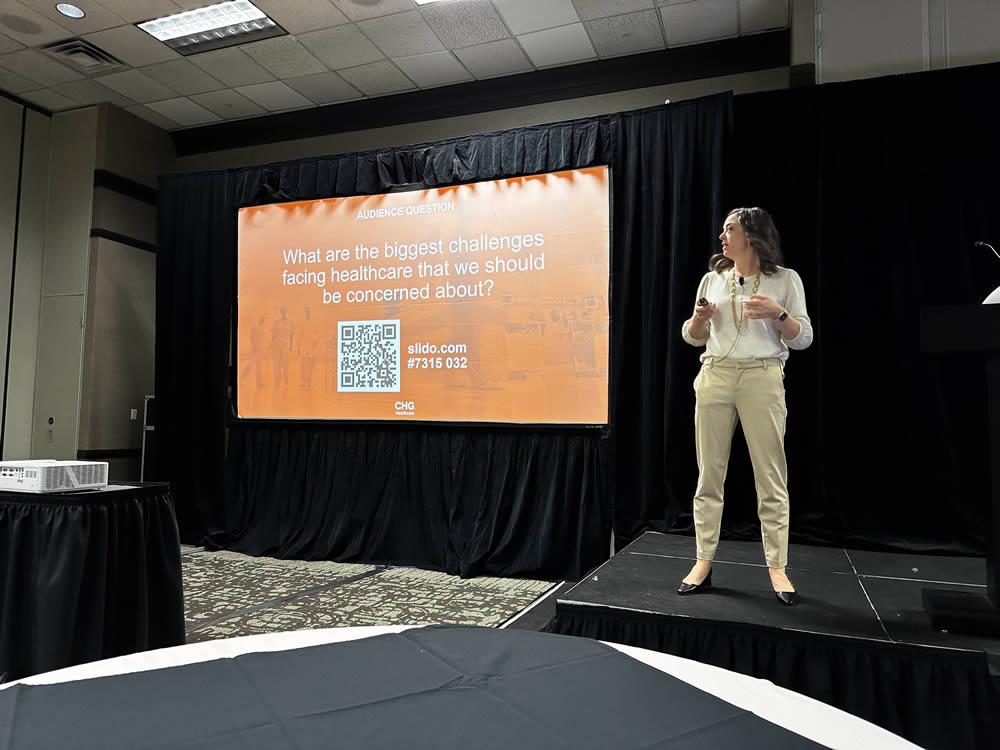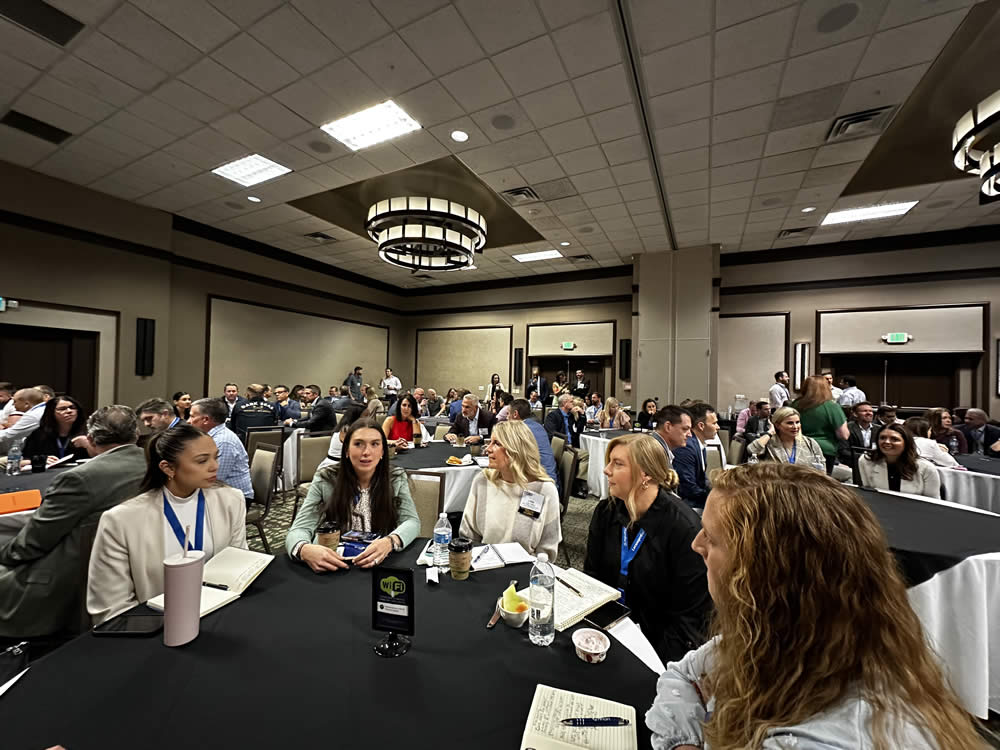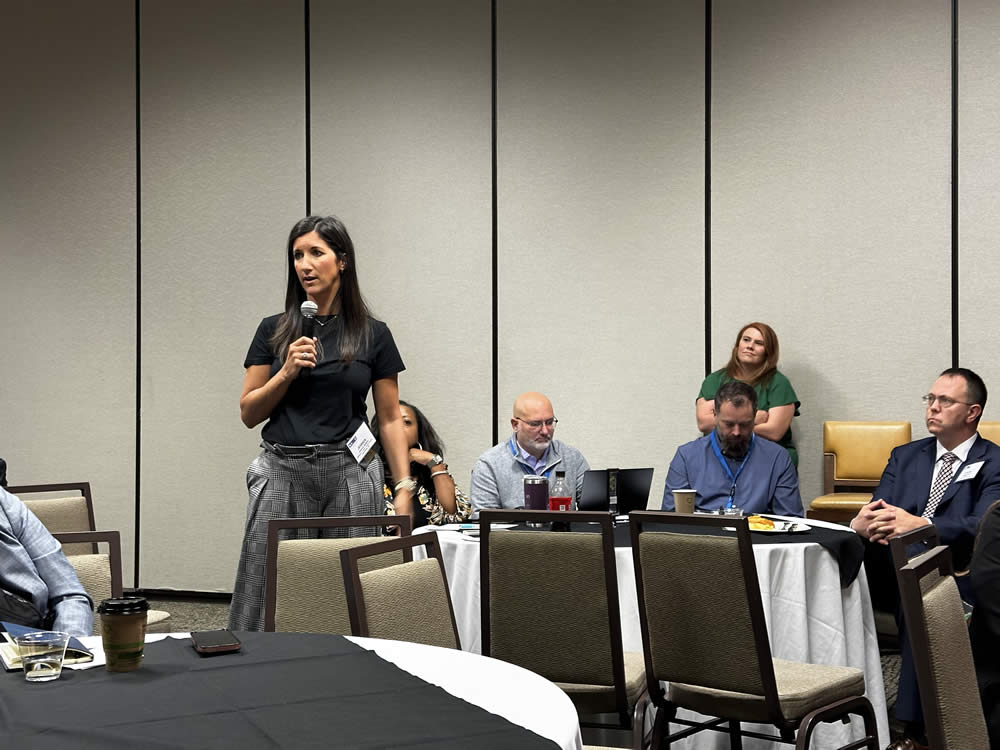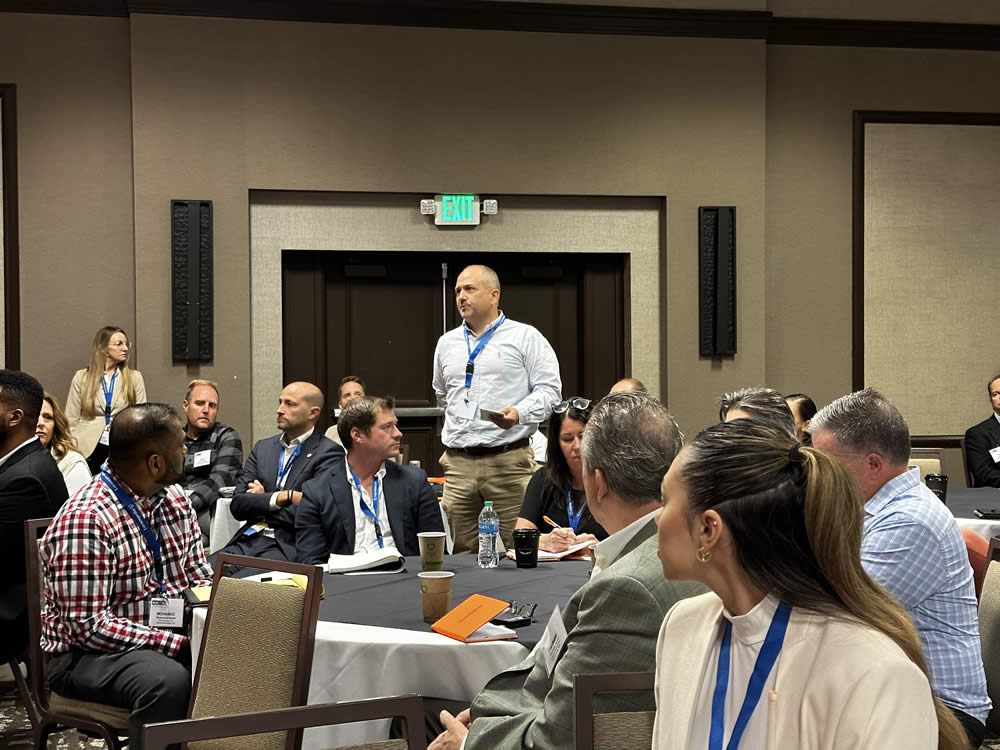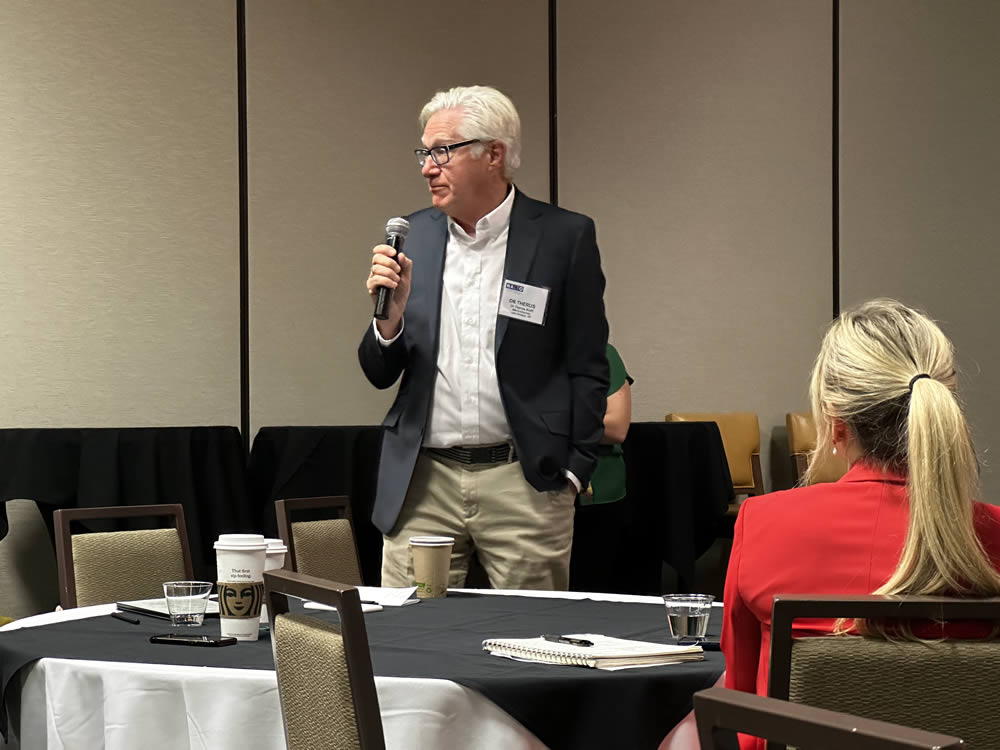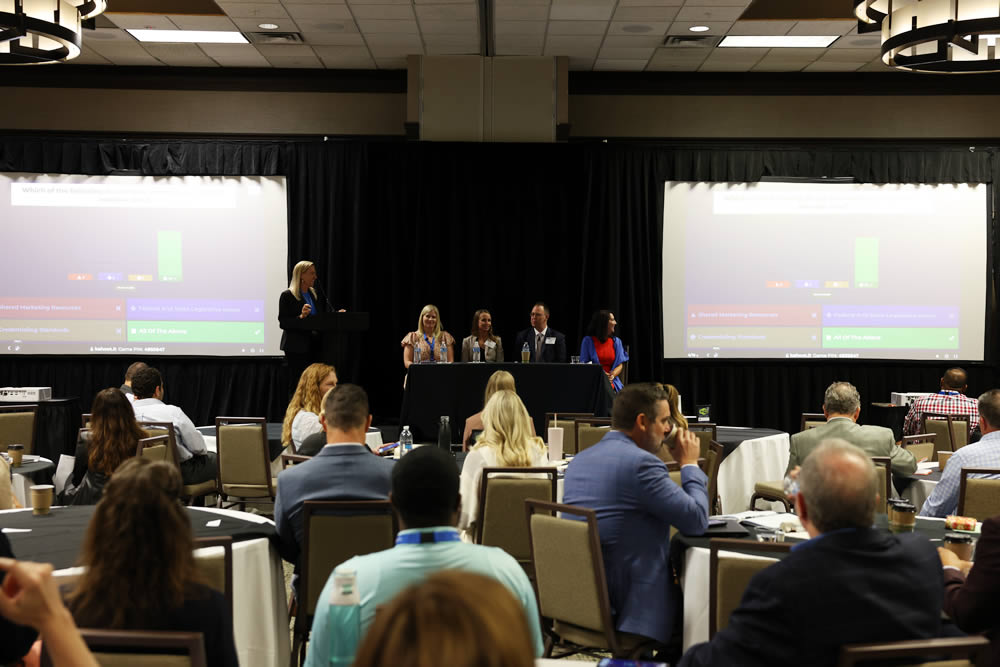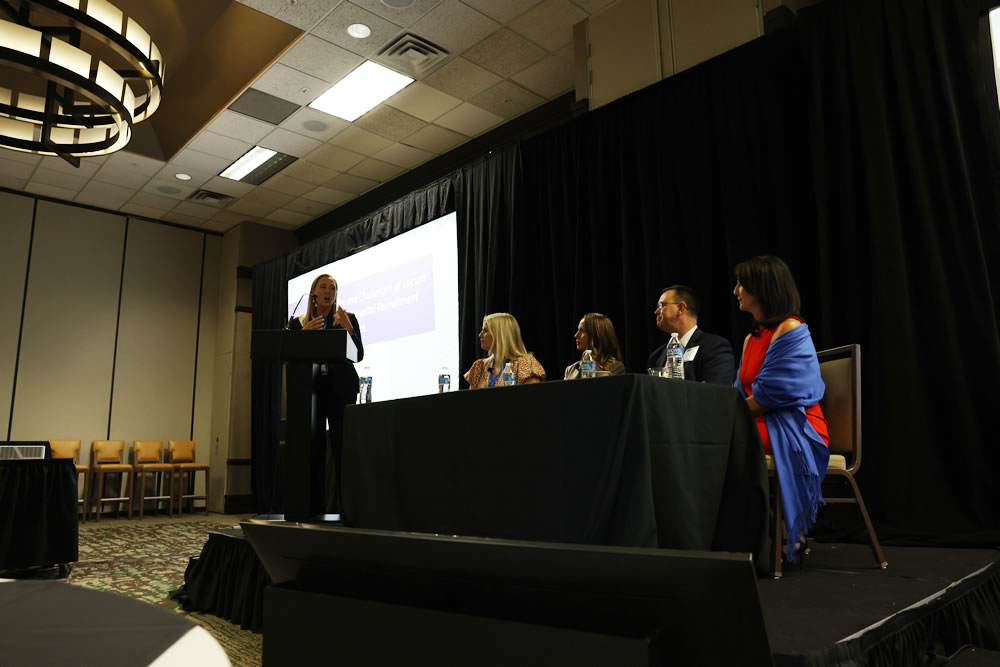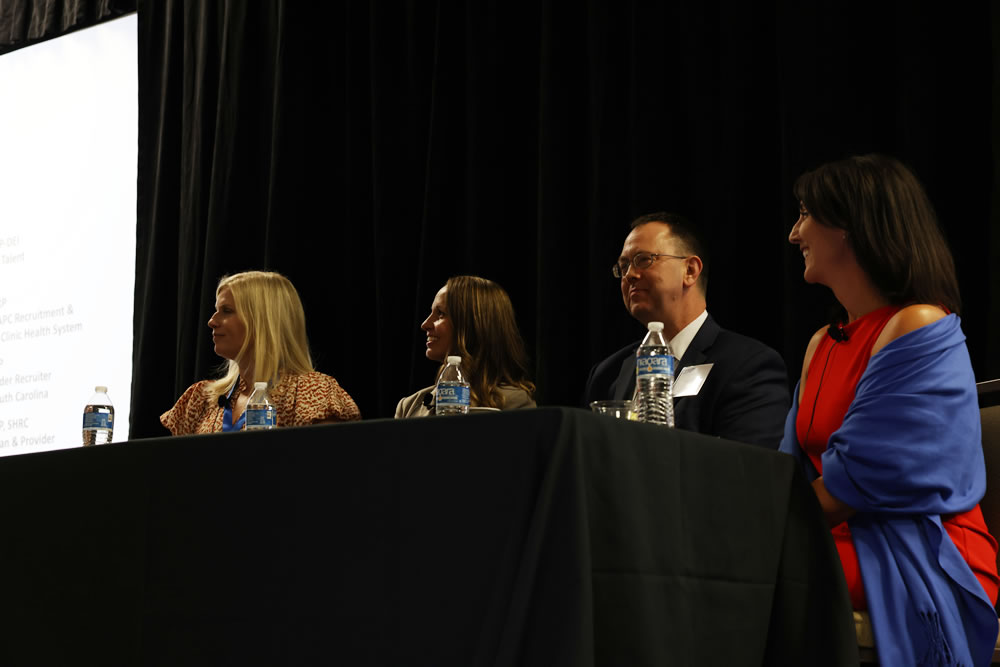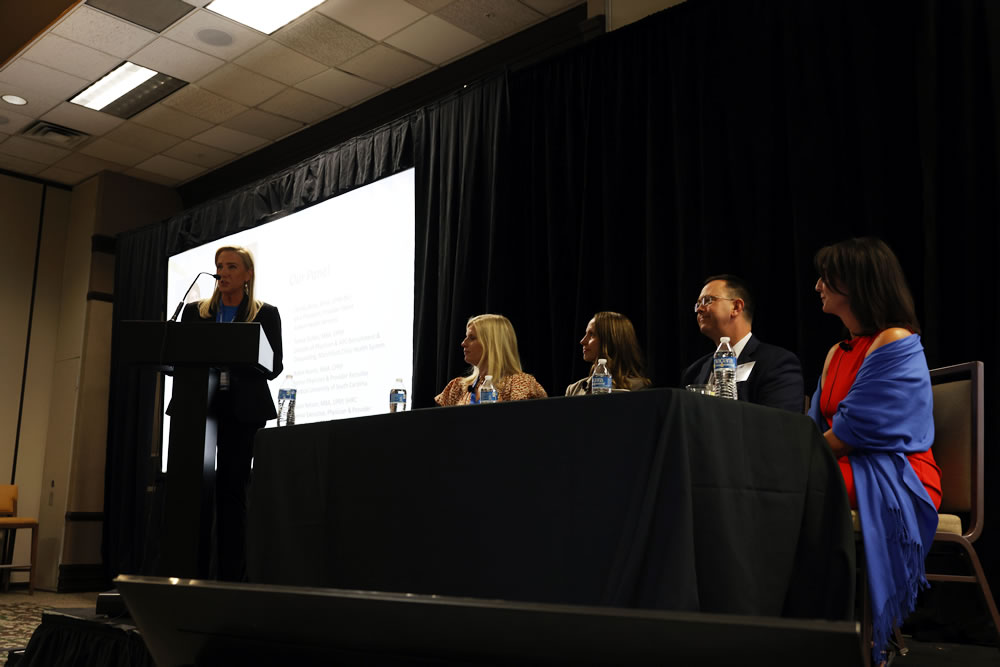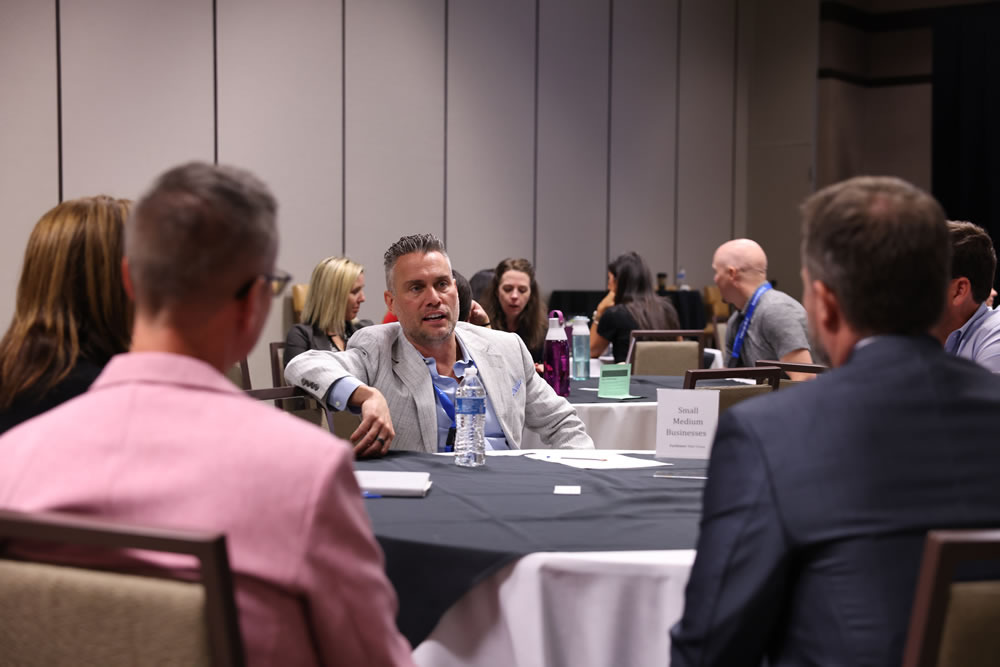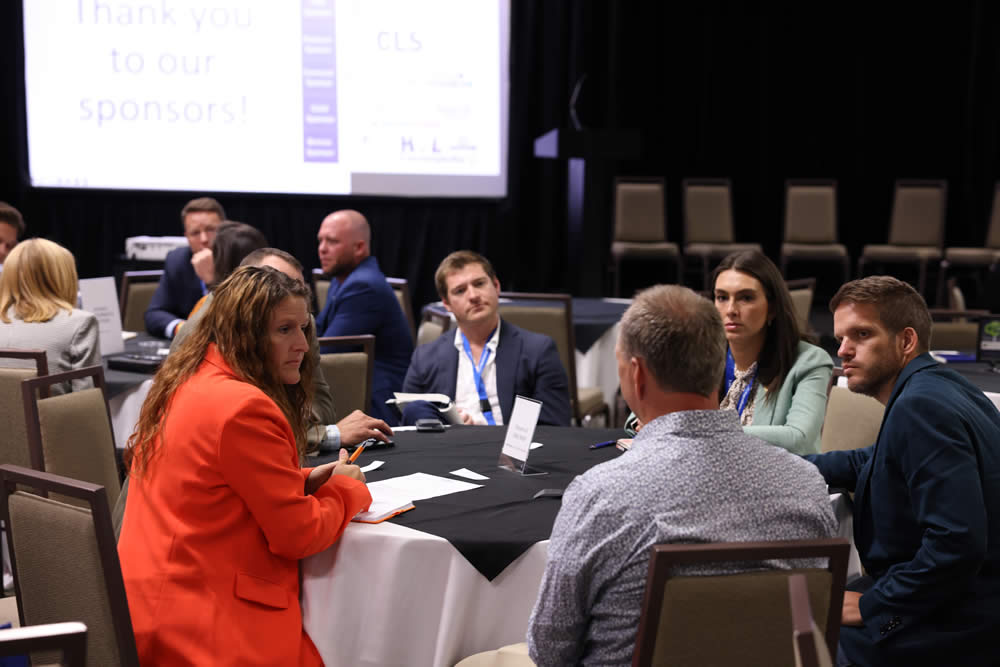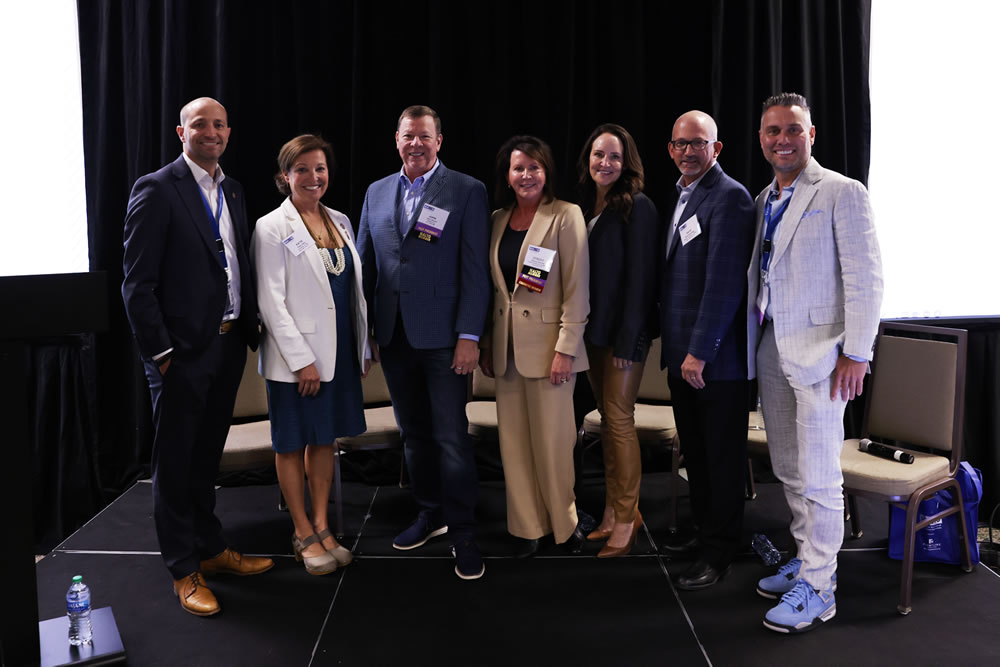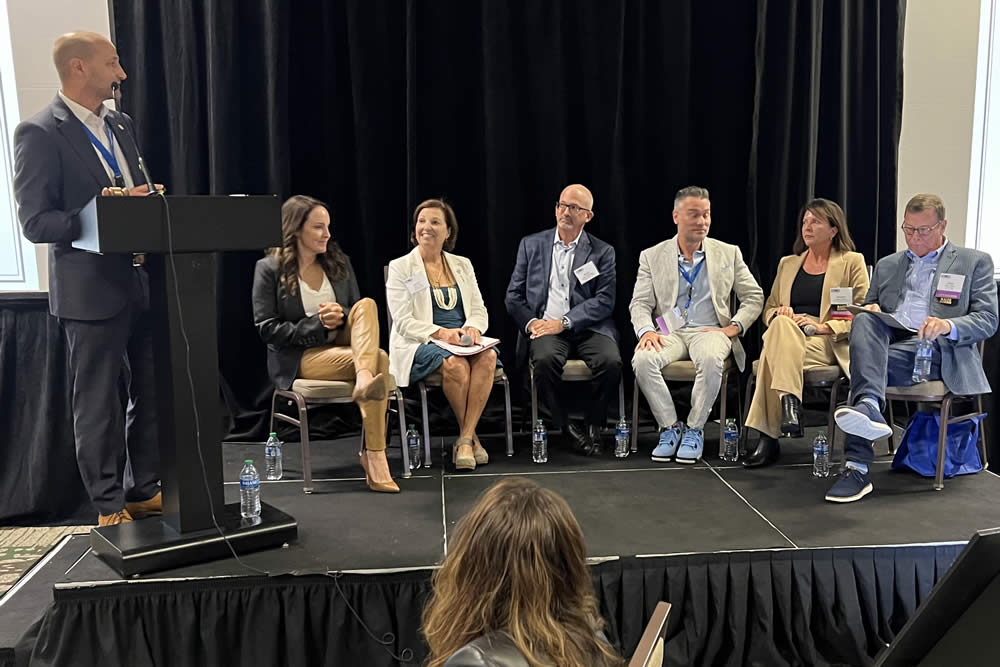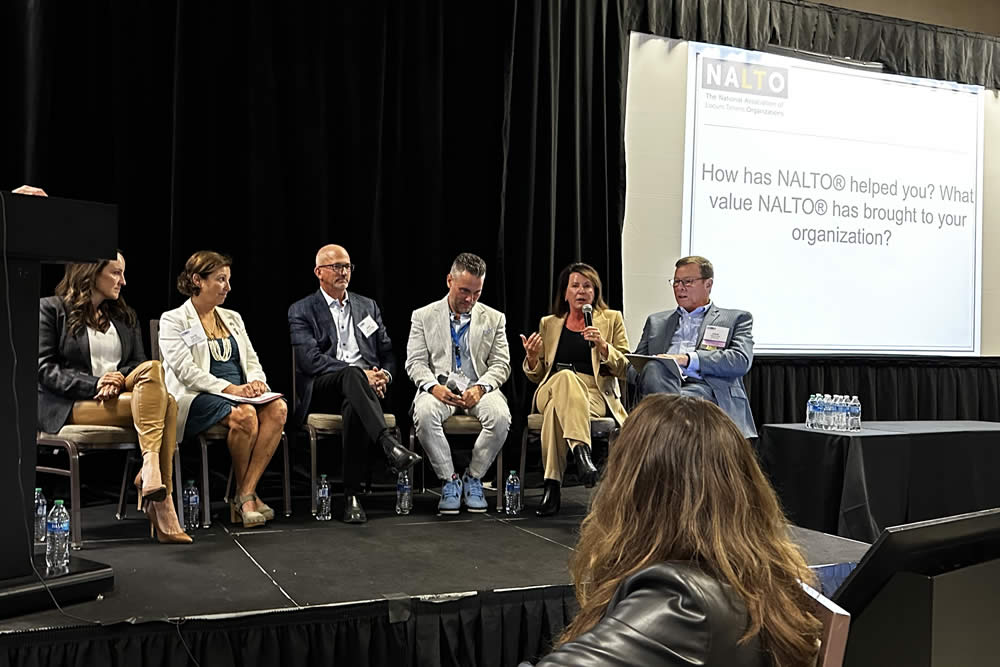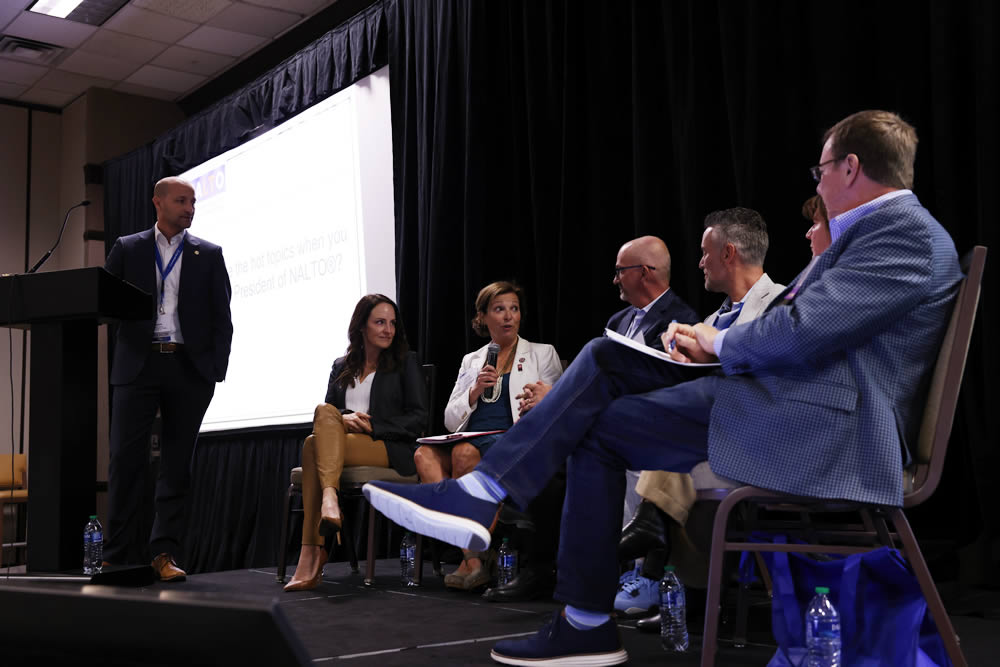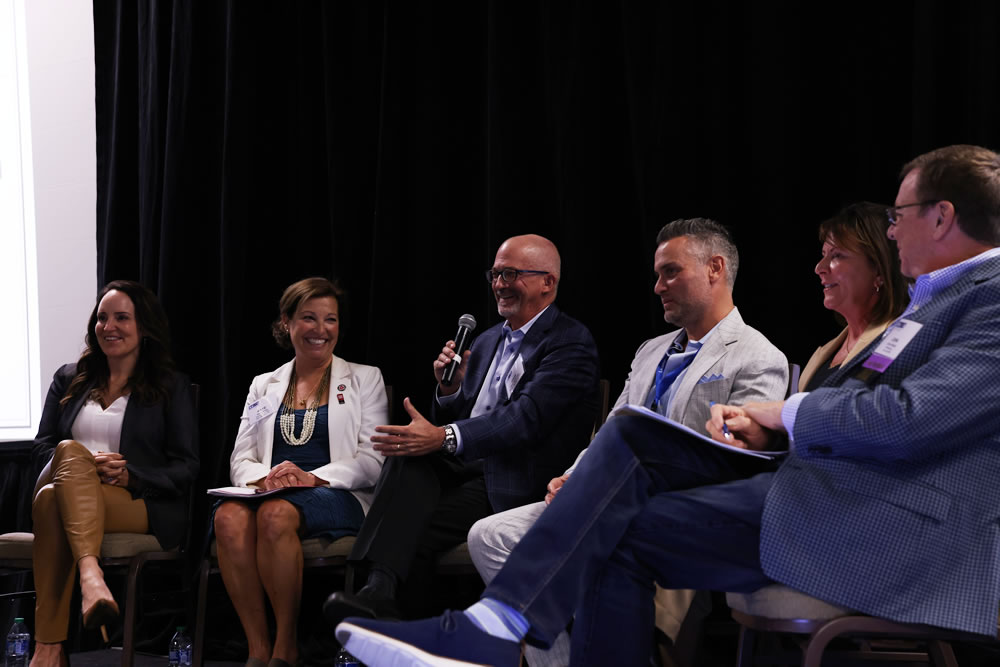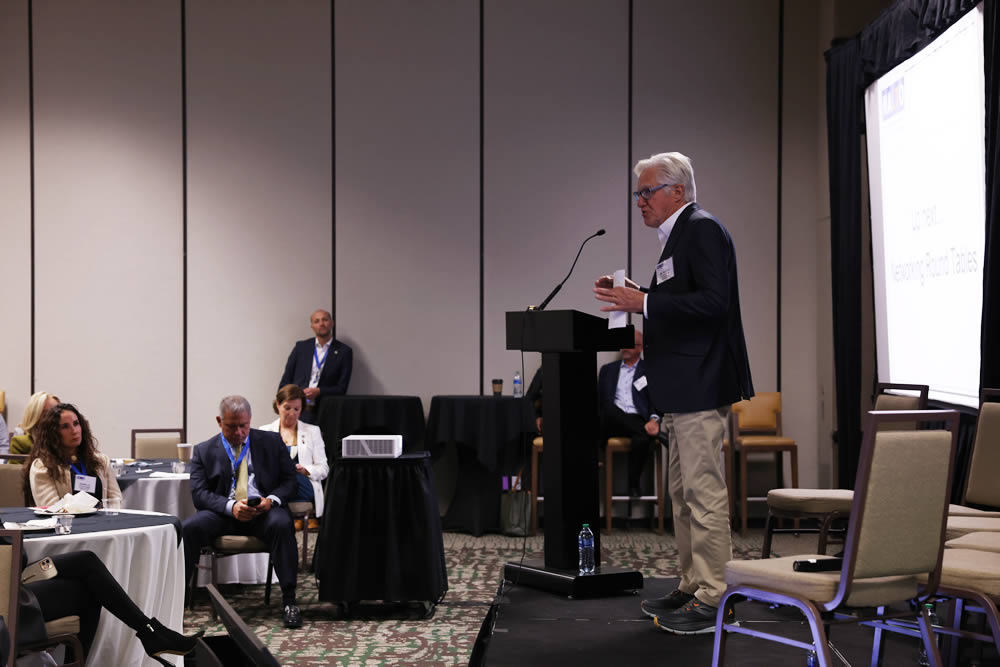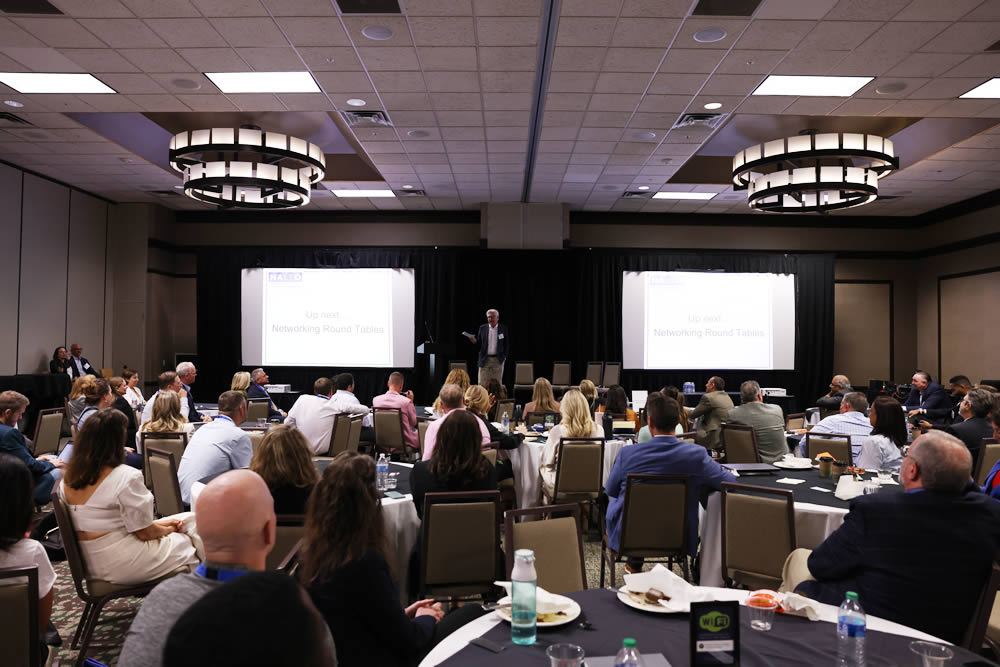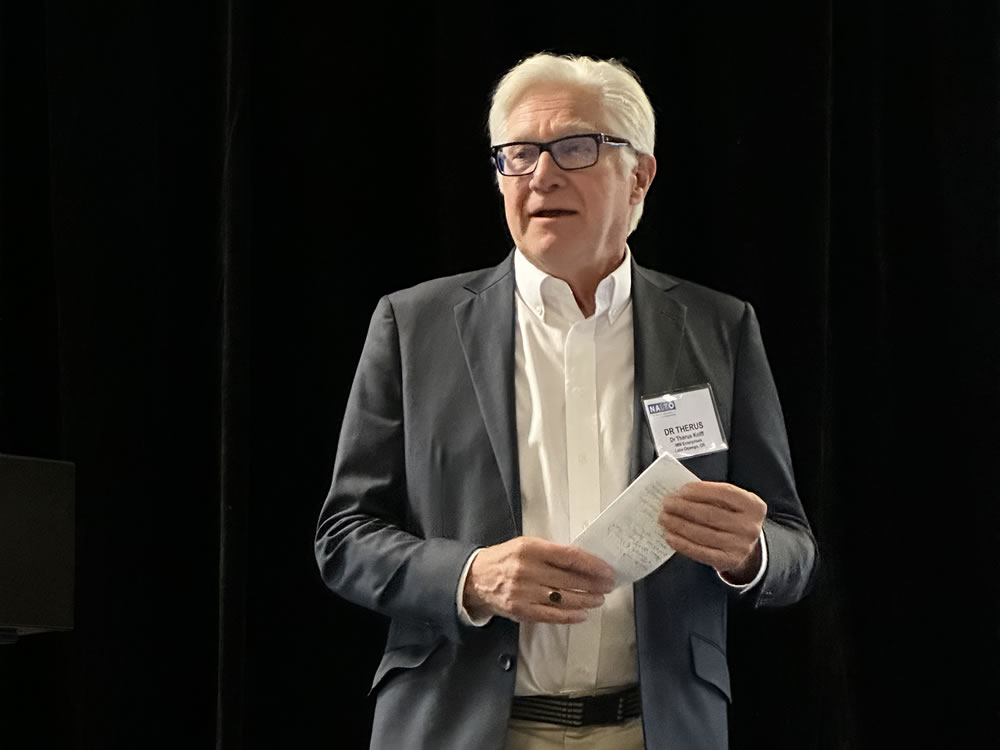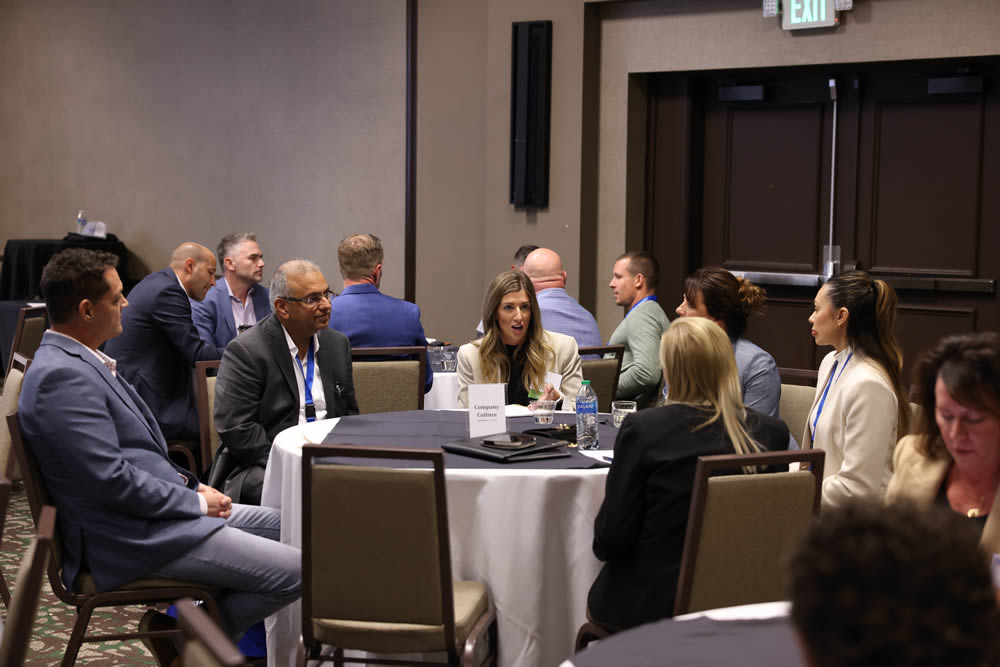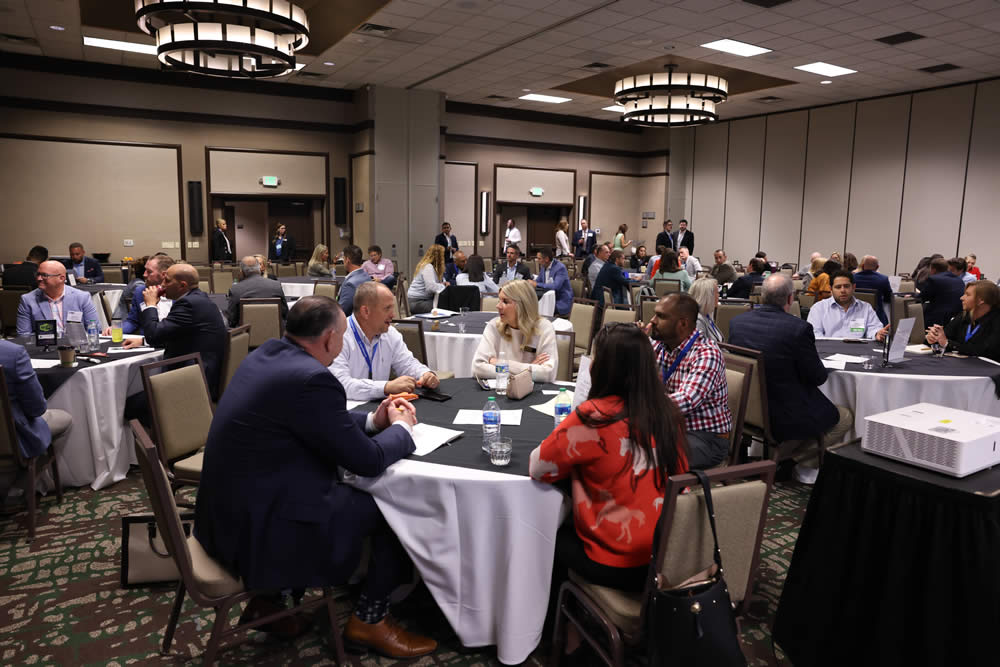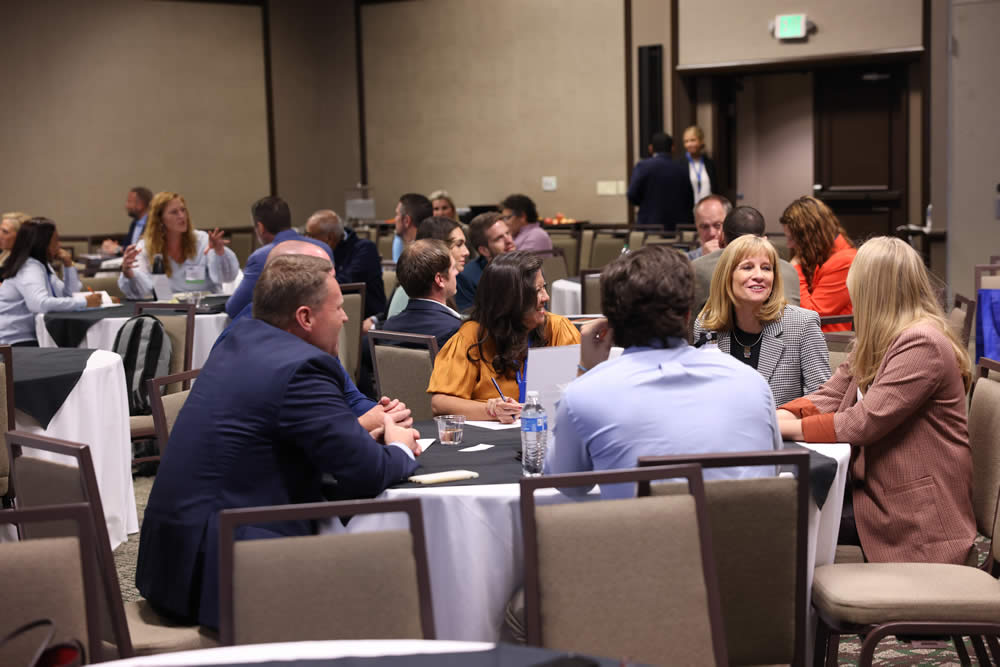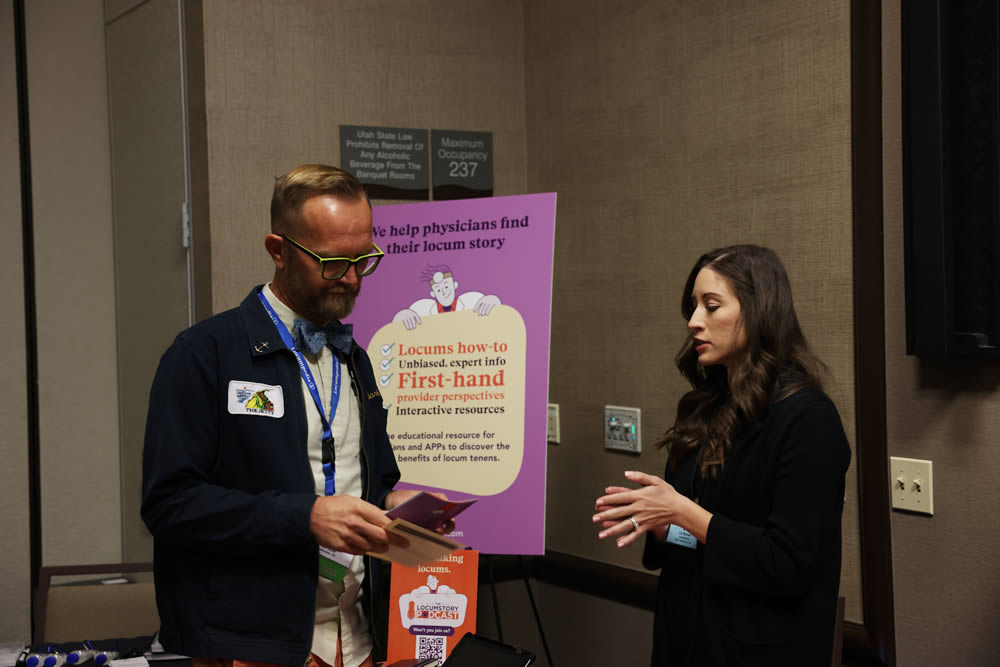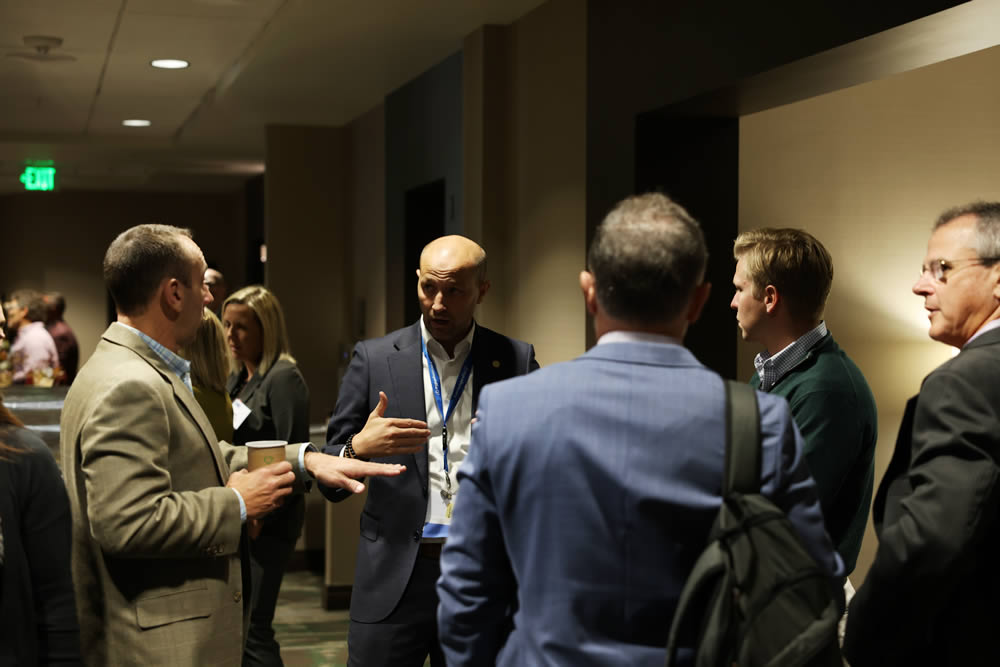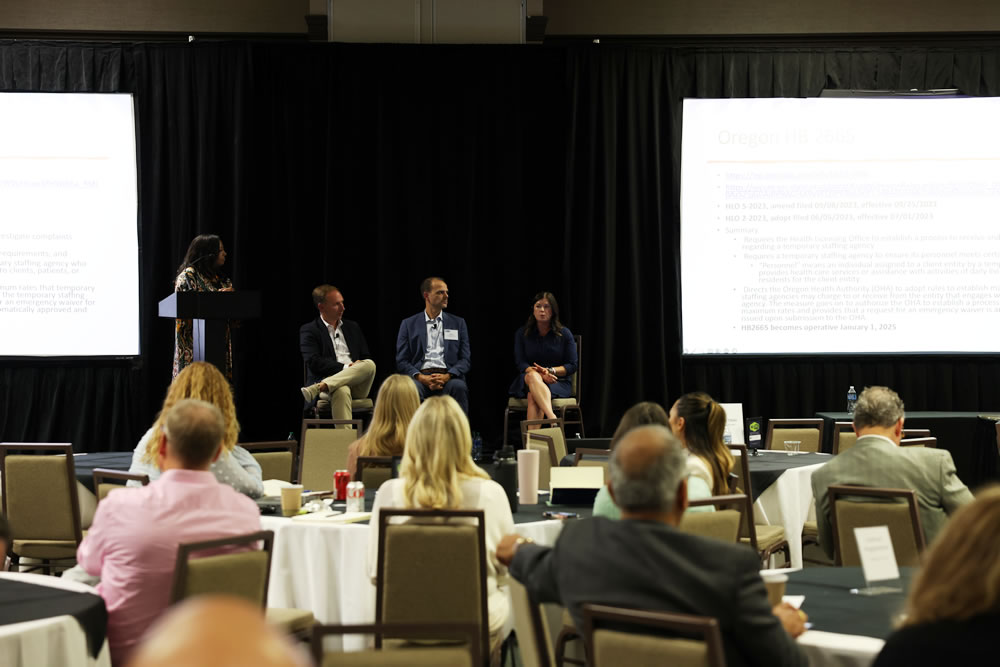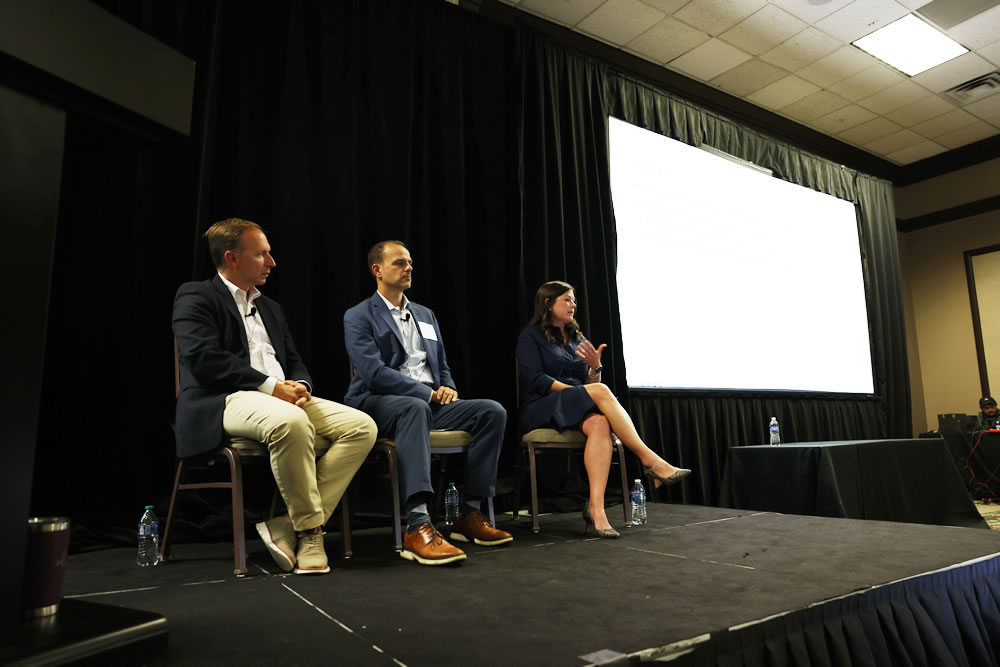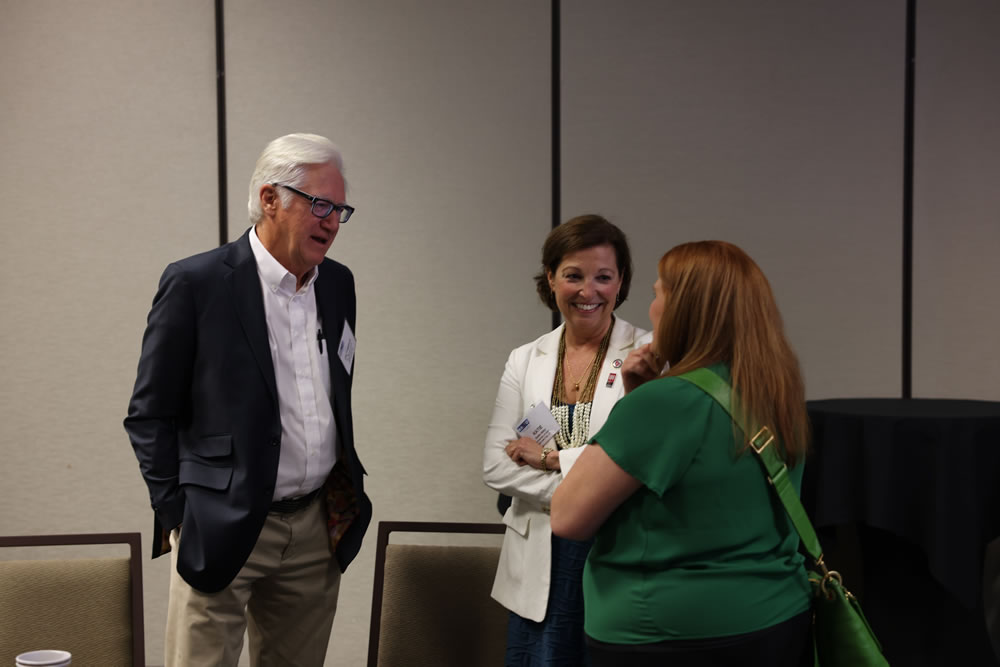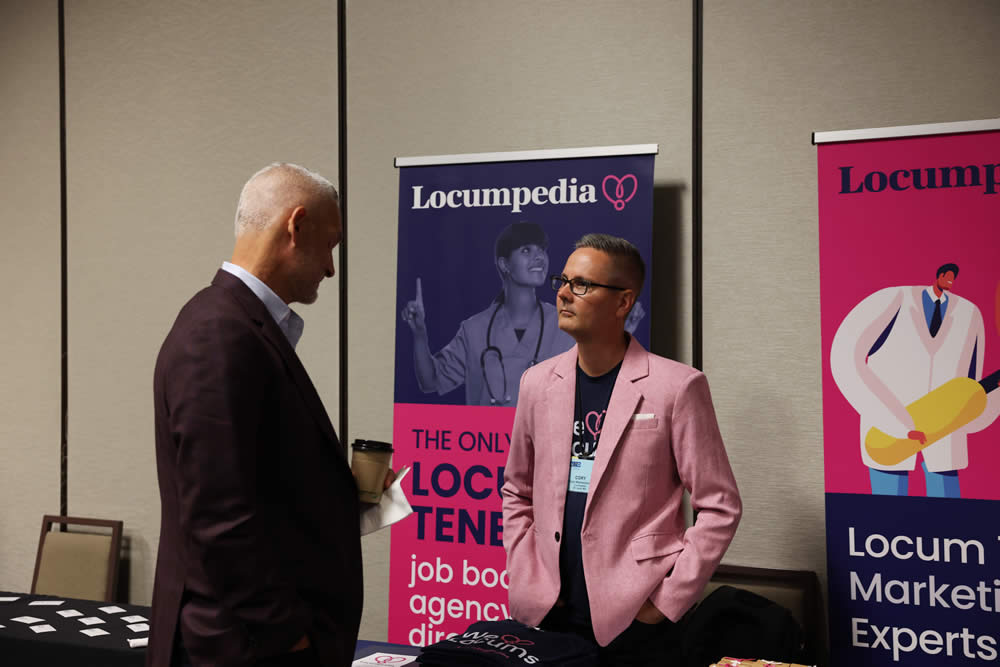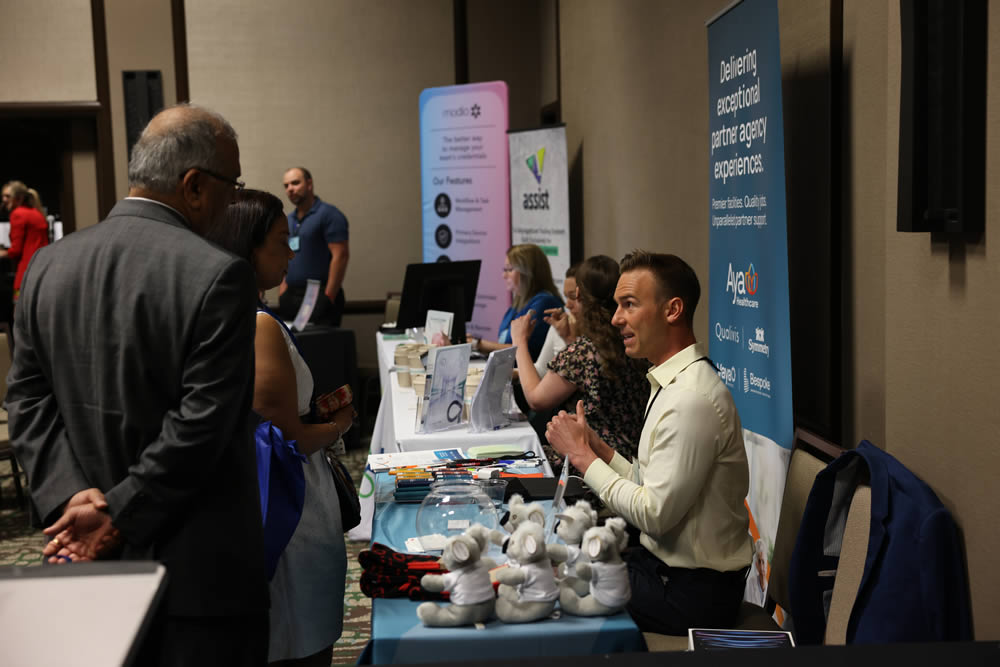Last week, more than 180 locum tenens industry leaders, agency reps, vendors – even clients and providers – attended the 2023 NALTO Fall Fly-in in Park City, Utah, a few thousand feet above Salt Lake City.
The event was the most-attended Fly-In of all time, according to new NALTO President Jarin Dana. The Doubletree in Park City was filled with locums professionals for the better part of two days. Day One started late in the afternoon on Tuesday with roundtable discussions, which were primarily used as opportunities to catch up with old colleagues and friends, meet new faces, and find commiserate over hors d’oeuvres and drinks at The Mustang, a staple on Main Street downtown.
And that was just an appetizer for an action-packed Day Two on Wednesday, which explored the many challenges facing the industry and lessons from the past that can propel the industry forward.
Day One Gallery
Keynote Presentation: The State of Locum Tenens
Many in the industry would agree that it just feels better to market an important product or service that truly matters to people — one you feel good about. That’s one of the key benefits of working in the locum tenens industry. So says Teri Gibson, VP of Marketing for CHG Healthcare, who gave a superlative opening keynote address Wednesday morning.
Gibson spent the first 15 years of her career supporting various B2C brands, but she refers to that part of her life as only the “first stage of her career” because locums taught her she could enjoy what she does while also helping others.
“We get to change clinicians’ lives, patients’ lives, and their community,” Gibson says. “We’re doing something that matters and makes a difference.”
She talked about the importance of those community relationships. She pulled from her personal experience staffing locums providers in a rural Nebraska town in a hospital to which her grandfather had recently been admitted.
“I know that hospital. CompHealth has brought several locums there because it’s very rural,” Gibson says. “I don’t know if my grandpa saw a locum provider, but I know that their staff is made up of a combination of physicians there and locums we staff.”
It’s important to hear these personal stories and understand how people in these communities feel about locums, Gibson said. She presented eye-opening statistics on the industry that were collected from studies performed by CHG, focusing specifically on physicians and healthcare organizations, or HCOs.
“We can start with a wide view of the healthcare market and look at the shortage that’s coming and think, ‘Is this going ever to get better with technology advancements, improving the pipeline of physicians – or anything else?’” Gibson says. “The answer is ‘no.’ We will likely see a gap of between 37,000 to 124,000 physicians by 2034.”
Gibson cited several reasons for the worsening shortage. She says the average age of retiring physicians is about 53 and that 29% of active physicians will retire between the ages of 60 and 65. She credited burnout as the biggest reason for early retirement, with 54% of physicians saying last year they were “severely burnt out.”
The solution is not to ask those physicians to work longer hours or for longer in their lives, she says. Perhaps one of the best ways to treat provider burnout in HCOs is to use locum tenens physicians and advanced practice providers. While that’s a neat little trick we all know well, locum tenens providers increase facility costs, and plugging staffing shortages with temporary providers contributes to a vicious cycle.
Despite these challenges, the locums industry is seeing robust growth. Some other points Gibson called out in her keynote:
- Locum tenens staffing has seen a 10% compound annual growth rate (CAGR) over the past five years.
- 7% of active physicians work locums assignments, and 21% have worked locums in the past but aren’t now.
- The impression of locum tenens has improved from a 24% favorability rate to 70% in the past 10 years.
Gibson also said that a decade ago, 11% of physicians were interested in working locums. Fast forward to 2023, and that number has increased to just 19%. She added that most physicians who accept these assignments don’t intend to work locums for more than three years. So, while the industry is growing, it could be growing even more!
One of the handful of providers in the audience, Dr. Naomi Lawrence-Reid, a board-certified pediatrician and founder of Doctoring Differently, educates physicians of all specialties about careers outside of full-time clinical medicine. She shared why more doctors aren’t encouraged to pursue locum tenens.
“When I was in residency in 2014, we were actively told that ‘locums aren’t real doctors,’” she says. “Our mentors are lifelong academics who have never worked locums, and so they are discouraging temporary assignments. We need to breach the walls of academia if we ever want to have some success generating interest in locums.”
Gibson ended the discussion by charging the audience to work together to grow the locum tenens industry and generate more interest and awareness of this staffing model. She said ultimately, it will take the hard work of staffing professionals and client leaders in the room to see this breakthrough come to fruition.
Day Two Gallery: Keynote Address
Hospital Execs on Locum Tenens Benefits & Challenges
The day’s second panel featured a slate of hospital recruitment executives:
- Robin Revels of the Medical University of South Carolina
- Jason Nelson of SSM Health
- Tarese Dubiel of Marshfield Clinic Health System
- Christy Ricks of Ardent Health Services
The consensus on the panel was that the most significant reason they utilize locum tenens providers in their hospitals is to “keep the doors open” as a trauma center, which is why they frequently use locum providers for emergency medicine docs, neurosurgeons, orthopedic surgeons, and more.
Ricks said her organization has seen a 30% year-over-year increase in locum tenens utilization, and she expects this rate to remain the same this year. Dubiel added that her system has “significantly increased” its use of locums over the past 10 years.
“We’ve got a lot of baby boomers on staff looking to retire,” Dubiel says. “We anticipate it will continue to grow even though the locums spending is greater.”
Nelson says he’s found locum providers he trusts but credits the work of staffing agency pros who perform much-needed due diligence before sending him a CV.
“I haven’t had to have a ‘come to Jesus’ moment with any of the recruiters because the candidates have been so good,” Nelson says. “A good recruiting partner is somebody I can always reach, or who will return my calls. I don’t keep traditional hours, and if I’m texting or calling, something is wrong.”
Dubiel agreed, adding that the only real deterrence from using a recruiter for locums is if they’re “unprofessional” and don’t take time to understand the company’s culture and the types of candidates who would be a good fit for her hospital.
“We love working with a single point of contact, so we only have one person to go through,” Revels agreed. “I work for a community-based hospital, and I love being able to work with locums. “I think you [recruiters and providers] are a tremendous value to everybody you touch. You’ve helped save some tails.”
Day Two Gallery: Hospital Execs Panel
NALTO: ‘The Friendliest, Most Collaborative Professional Organization’
During the highly informative – and surprisingly entertaining – “Past, Present, and Future Presidents” session, five former NALTO presidents discussed the industry’s evolution, offering unique perspectives from those who have filled the association’s top leadership role and who’ve seen NALTO through its birth to the present day.
The panel began at lunchtime with an unofficial transfer of the NALTO gavel and president title from immediate past president Matt Young of All Star Healthcare Solutions to newly appointed Jarin Dana of Fusion Healthcare Staffing. Then Young took a seat on stage alongside former NALTO presidents Katie Hoffman-Addy, (Assistant Dean and Special Advisor to the University of Utah), David Baldridge, (former COO of CHG Healthcare), Melissa Byington, (CEO of Syncx,) John Daniel (EVP of VeloSource), and Stacey Stanley, (Advisor and Board Member of Caliber Healthcare Solutions.)
Baldridge and Hoffman-Addy spoke about the early, halcyon days of locum tenens and of NALTO’s founding in 2001. Baldridge said he felt a swell of pride, on stage in front of a packed room of locum tenens leaders.
“I think the first Fly-In had six people meeting at Chicago O’Hare,” he said with a laugh. “This is pretty awesome. The focus of NALTO back then was around education and helping new companies come up to speed in terms of credentialing. At that time, the industry began to mature, but it was still a little bit of the Wild West.“
When Hoffman-Addy started in the locum tenens industry in the ‘80s, the leading concern agencies faced was convincing medical facilities that locum tenens providers were qualified at all.
“That filtered along for many years, and then there was a malpractice crisis when claims were off the charts, and insurance companies raised premiums like you wouldn’t believe,” she said. “This whole industry was in danger of going away because they couldn’t afford malpractice insurance.”
The concern surrounding provider quality was high, she said, and in an industry so new, its members needed to come together, put aside competitive differences, and “play nice in the sandbox” to ensure patients continued to receive quality care.
Young applauded the work of former presidents and staffing pros in the audience who had put aside those differences to help the industry grow into what it is today.
“Just looking around at the audience and the numbers of organizations, you can see how much NALTO has grown,” Young says. “We’ve grown this organization and given NALTO a national voice, something previously being handled by larger firms doing their lobbying trying to educate HCOs.”
Byington offered personal advice for agencies who haven’t taken advantage of the myriad resources available to NALTO members. There’s a vast network of individuals who understand the problems each other faces, and you can always rely on others to help when called upon.
“This is the friendliest, most collaborative professional organization I’ve ever been a part of,” Byington says. “While the growth of this industry has changed, the reasons physicians do locums remain the same. There are a lot of things we can get done by working together in the next five years.”
Many of the conversations followed the same line of thinking. Baldridge said that, while many different agencies were represented in the room, they were all working together to continue the work to advance locum tenens.
“What makes locums a great industry — you’ve heard it from just about everybody involved with the business — is that here, at the end of the day, without your efforts, thousands of people would go without healthcare or with delayed healthcare,” he said. “What a difference it makes to them. I don’t know of another industry that has provided so much for so many people, including growth, friendships, financial security, and other things.”
The president’s panel concluded with closing remarks from one of the founders of locum tenens, Dr. Therus Kolff – co-founder of CompHealth and on Icon Medical’s board – who said “how cool it was” for him to see all of these people together in a room. It wasn’t lost on this author and of Locumpedia as a whole that Dr. Kolff gave a nice shoutout about our landmark “Locum Legends” series for 2023 National Locum Tenens Week, which featured Dr. Kolff prominently as a founding figure.
It was a full circle moment for him, witnessing how the industry has evolved since those early days and seeing faces who cared about locum tenens as much as he did when he formed and co-launched the locum tenens movement 44 years ago. The amount of care in that room for this profession is one of the industry’s greatest strengths.
“We’ve always had threats,” Dr. Kolff says. “They are going to come up and continue, but one thing will not change: our commitment to quality care. The demand is going to continue growing. There is plenty of room for growth without cutting corners [in recruiting]. Don’t be afraid of competition, play nice in the sandbox, and remember – we are filling a huge need with every decision we make. Everything we do should only be about taking care of patients.
“Good luck to you.”
Day Two Gallery: Presidents Panel & Roundtables
Legislative Session: But Today, We Are Still Just a Bill
To conclude the day’s sessions, conferencegoers joined a panel highlighting NALTO’s lobbying efforts in Washington, DC, and with state governments. The panel was moderated by Tanika Williams, Division Vice President Anesthesia & Radiology, Jackson + Coker Locum Tenens. Panelists discussed NALTO’s legislative agenda and explained agencies can become advocates for NALTO and the industry at large.
Amber Sprengard, VP of government affairs for Caliber Healthcare Solutions (formerly Health Carousel Locum Tenens), gave a brief, high-level rundown of each of the 17 new bills passed or under review in states nationwide.
“I love giving this update,” Sprengard says. “I wish I had better news that all the work we did last year led to a place where we didn’t have to worry about state legislation, but that wasn’t the case. “Last year, we saw a number of states introduce legislation for oversight for healthcare staffing, in general.”
Sprengard spoke about bills that created an “unbelievable burden” for state departments of health, that were vague, and that were clear indications the legislators did not “understand the nuance” of locum tenens firms. She stressed the importance of reaching out to local legislators to better educate them on locums.
You, dear reader, can learn more about bills affecting your specific state by contacting NALTO and becoming an advocate for locum tenens on a federal level.
The second half of the panel was led by Ryan Bernstein, senior VP of federal public affairs at McGuireWoods Consulting, and Jeffrey Britt, senior VP of McGuireWoods Consulting Advocacy.
Bernstein and Britt spoke about NALTO’s work to help introduce the Healthcare Provider Shortage Minimization Act, which would codify locum tenens providers as 1099 contract workers and ensure underserved communities continue to access skilled locum tenens professionals.
“Several members met with us in D.C. in July when we talked with about 25 legislators about locums,” Bernstein says. “We’re now on the offensive. Things may flip after the election, but we always knew we could make this move forward by focusing on members of Congress who were aware of the industry — some of them were doctors. We talked to staff who knew the field and many who had no idea.
“We want things to change and to evolve, and so that comes down to continuous education of what’s going on in the industry.”
Britt agreed and encouraged members to reach out to their elected officials and show them the value of locums in their community.
“We need everyone here to educate leaders about this profession,” Britt says. “We want them to recognize the work providers are doing for these patients and that they are getting crucial access to the coverage they need.”


